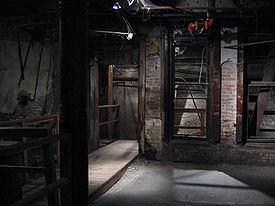
An image of the "Seattle Underground"—in the mid-1800s, the facade seen here was at street level
The
Seattle Underground is a network of underground passageways and basements in downtown Seattle, Washington, United States that was ground level at the city's origin in the mid-19th century. After the streets were elevated these spaces fell into disuse, but have become a tourist attraction in recent decades.
History

Start of the Great Seattle Fire, looking south on 1st Ave. near Madison St.
Seattle's first buildings were wooden. On June 6, 1889 at 2:39 in the afternoon,
[1] a cabinetmaker accidentally overturned and ignited a glue pot. An attempt to extinguish it with water spread the burning grease-based glue. The fire chief was out of town, and although the volunteer fire department responded they made the mistake of trying to use too many hoses at once. They never recovered from the subsequent drop in water pressure, and the Great Seattle Fire destroyed 31 blocks.
[2]
While a destructive fire was not unusual for the time, the response of the city leaders was. Instead of rebuilding the city as it was before, they made two strategic decisions: that all new buildings must be of stone or brick, insurance against a similar disaster in the future; and to regrade the streets one to two stories higher than the original street grade. Pioneer Square had originally been built mostly on filled-in tidelands and, as a consequence, it often flooded. The new street level also assisted in ensuring that gravity-assisted flush toilets that funnelled into Elliott Bay did not back up at high tide.

Brick arches provide the ceiling for the underground corridors and support the hollow street sidewalks
For the regrade, the streets were lined with concrete walls that formed narrow alleyways between the walls and the buildings on both sides of the street, with a wide "alley" where the street was. The naturally steep hillsides were used, and through a series of sluices material was washed into the wide "alleys", raising the streets to the desired new level, generally 12 feet higher than before, in some places nearly 30 feet.
At first pedestrians climbed ladders to go between street level and the sidewalks in front of the building entrances. Brick archways, as seen in the image to the left, were constructed next to the road surface, above the submerged sidewalks. Skylights with small panes of clear glass (which later became amethyst-colored because of manganese in the glass) were installed, creating the area now called the Seattle Underground.

The concrete floor of the former meat market was originally at the level of the wooden platform on the left, but sank over time because of decomposing sawdust fill.
When they reconstructed their buildings, merchants and landlords knew that the ground floor would eventually be underground and the next floor up would be the new ground floor, so there is very little decoration on the doors and windows of the original ground floor, but extensive decoration on the new ground floor.
Once the new sidewalks were complete, building owners moved their businesses to the new ground floor, although merchants carried on business in the lowest floors of buildings that survived the fire, and pedestrians continued to use the underground sidewalks lit by the glass prisms (still seen on some streets) embedded in the grade-level sidewalk above.
In 1907 the city condemned the Underground for fear of bubonic plague, two years before the 1909 World Fair in Seattle (Alaska-Yukon-Pacific Exposition). The basements were left to deteriorate or were used as storage. Some became illegal flophouses for the homeless, gambling halls, speakeasies, and opium dens.
Only a small portion of the Seattle Underground has been restored and made safe and accessible to the public on guided tours.
Seattle Underground Tour

A former bank; the vault door is in the background on the right
In 1965, local citizen Bill Speidel realized there might be interest (and profit) in the subterranean ruins. He established "Bill Speidel's Underground Tour" and took customers on a tour of what was left underneath Pioneer Square, paying rent to the building owners for the privilege of doing so. He peppered his tour patter with tall tales from Seattle's history (some more factual than others), giving the tour an amusing counterculture feel that made it an "underground" tour in every sense of the word.
Over the years the tour has become more popular, and the underground structures have been steadily refurbished to be more visually appealing. The tour remains a popular attraction for visitors and locals alike.





No comments:
Post a Comment